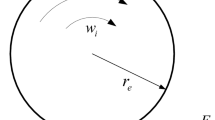Abstract
The adaptive cruise control system maintains the appropriate distance to the lead vehicle when the lead vehicle exists and maintains the desired speed when no lead vehicle is detected. A virtual lead vehicle scheme is introduced to make the switching between the speed control algorithm and the distance control algorithm unnecessary and simplify the structure of the control system. The speed and the position of the virtual vehicle can be decided by the control system according to the current situation. Smoother responses are achieved by the virtual lead vehicle scheme compared to the conventional mode switching scheme. This method is also shown to provide a good reaction for when a lead vehicle cuts in or out. A linear quadratic controller with variable weights is suggested to control the virtual lead vehicle. This scheme shows improved performance in terms of passenger comfort and fuel efficiency of the host vehicle.
Similar content being viewed by others
References
Ahn, K., Trani, A. A., Rakha, H. and Van Aerde, M. (1999). Microscopic fuel consumption and emission models. Proc. 78th Annual Meeting of the Transportation Research Board, Washington DC, USA.
Bageshwar, V., Garrard, W. and Rajamani, R. (2004). Model predictive control of transitional maneuvers for adaptive cruise control vehicles. IEEE Trans. Vehicle Technology 53,5, 1573–1585.
Bose, A. and Ioannou, P. (2000). Environmental Evaluation of Intelligent Cruise Control (ICC) Vehicles. Proc. IEEE Conf. Intelligent Transportation Systems, Dearborn, 352–357.
Hedrick, J. K., McMahon, D., Narendran, V. and Swaroop, D. (1991). Longitudinal vehicle controller design for IVHS systems. Proc. American Control Conf., 3107–3112.
Ioannou, P. and Chien, C. C. (1993). Intelligent cruise control. IEEE Trans. Vehicular Technology 42,4, 657–672.
Ioannou, P. and Stefanovic, M. (2005). Evaluation of the ACC vehicles in mixed traffic: Lane change effects and sensitivity analysis. IEEE Trans. Intelligent Transportation Systems 6,1, 79–90.
Ioannou, P. and Xu, Z. (1994). Throttle and brake control systems for automatic vehicle following. IVHS J. 1,4, 345–377.
Kim, S. G., Tomizuka, M. and Cheng, K. H. (2009). Mode switching and smooth motion generation of the adaptive cruise control system by a virtual lead vehicle. IFAC Symp. Control in Transportation Systems’ 09.
Kim, S. G., Tomizuka, M. and Cheng, K. H. (2010). Smooth motion control of the adaptive cruise control system with linear quadratic control with variable weights. ASME Dynamic Systems and Control Conf. (DSCC).
Kwakernaak, H. and Sivan, R. (1972). Linear Optimal Control Systems. Wiley-Interscience. New York.
Rajamani, R. (2006). Vehicle Dynamics and Control. Springer. Germany.
Vahidi, A. and Eskandarian, A. (2003). Research advances in intelligent collision avoidance and adaptive cruise control. IEEE Trans. Intelligent Transportation Systems 4,3, 143–153.
Venhovens, P., Naab, K. and Adiprasito, B. (2000). Stop and go cruise control. Int. J. Automotive Technology 1,2, 61–69.
Yi, K., Hong, J. and Kwon, Y. D. (2001). A vehicle control algorithm for stop-and-go cruise control. J. Automobile Engineering. Proc. Institution of Mechanical Engineers, 215, Part D, 1099–1115.
Zhang, Y., Kosmatopoulos, E. and Ioannou, P. (1999). Autonomous intelligent cruise control using front and back information for tight vehicle following maneuvers. IEEE Trans. Vehicular Technology 48,1, 319–329.
Author information
Authors and Affiliations
Corresponding author
Rights and permissions
About this article
Cite this article
Kim, S.G., Tomizuka, M. & Cheng, K.H. Smooth motion control of the adaptive cruise control system by a virtual lead vehicle. Int.J Automot. Technol. 13, 77–85 (2012). https://doi.org/10.1007/s12239-012-0007-6
Received:
Revised:
Published:
Issue Date:
DOI: https://doi.org/10.1007/s12239-012-0007-6




